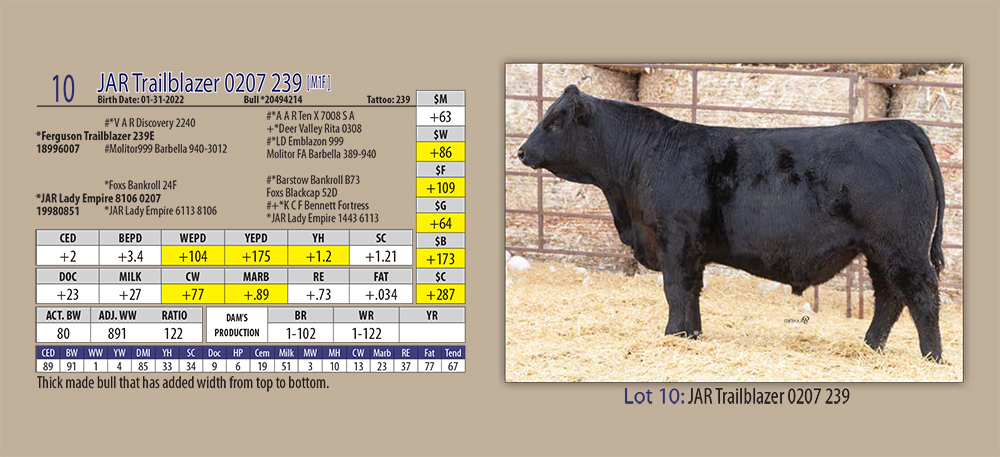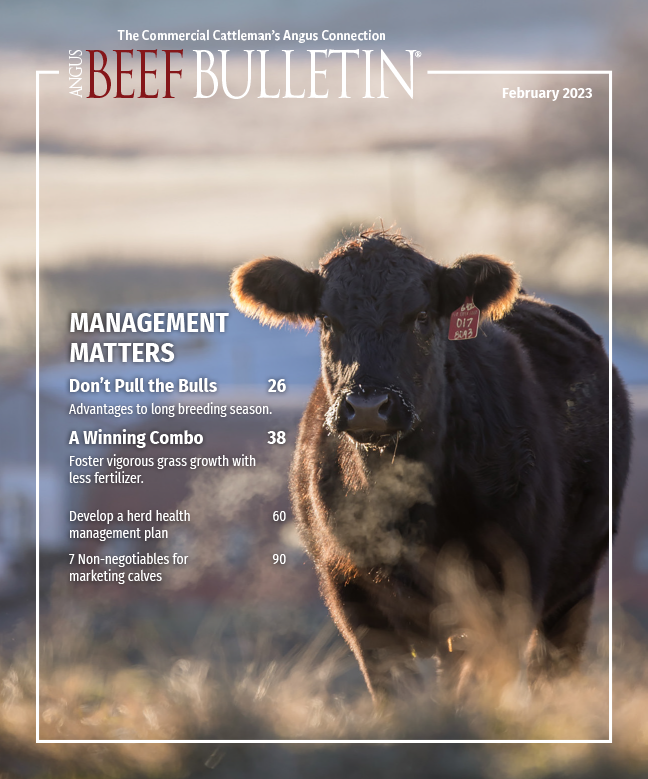
Bull-buying: It’s a Process
Process provides framework for making decisions that will influence profitability for years to come.
The bull purchase is one of the most consequential decisions any commercial cow-calf operation makes on a regular basis. It has such huge effects on a herd’s profitability — both immediate and long term. While the cows you select as replacements have a single calf each year, a bull is going to have 25-40 calves a year. The decisions you make on a bull become multigenerational if you keep daughters as replacements. Making the “right” decision can pay dividends; making the “wrong” decision can derail a herd for years.
The decision is even trickier when selecting young, unproven bulls. Luckily, there are a wealth of resources to mitigate risk and increase the likelihood we choose the right bull for our breeding goals. These tools, EPDs (expected progeny differences) and selection indexes, take some of the guesswork out of choosing sires. With this in mind, I wanted to walk through the process I use when it comes to sire selection.
1. Make a plan
It’s essential to know what we’re looking for prior to selecting a bull. There is no “one-size-fits-all” bull. The right sire for an operation that is selling weaned calves and keeping replacement females will be very different than the right sire for one that sells freezer beef.
Making a breeding plan includes evaluating which traits are important for maximizing a herd’s income (i.e., weaned calf pounds, red meat, etc.) and reducing its costs (i.e., heifer development, reproduction, feed, etc.). It is important to be conscious of our herd’s strong and weak points. This allows selection decisions to make up ground where our cows are currently lacking while driving continued improvement in other important areas.
Our breeding plan should also include identifying which breed of bull best allows us to take advantage of breed complementarity and heterosis through crossbreeding.
2. Do some homework
We can do most all of our work in sire selection before we get to the sale. Armed with a sale book, we can get an idea of an animal’s genetic potential and do some “cutting” before even looking at bulls. EPDs are our best statistical estimates of an animal’s genetic merit. They are essential tools for sire selection because they remove sources of environmental variation from a trait measurement and allow us to focus our decisions only on the component of a trait that an animal can pass to its offspring. Breed associations report EPDs for dozens of traits — from growth to maternal ability to carcass merit.
When we are performing multi-trait selection, the sheer number of EPDs can be hard to balance all at once, as some traits are more important than others, and genetic correlations exist between traits that can work in opposition to one another with regard to overall profitability (think weaning weight and mature cow size). Economic selection indexes weight individual EPDs by their real-world economic value. These indexes report a single value that allows us to compare the expected profitability of sires’ offspring in generalized production scenarios. The resulting index is effectively an EPD for profit reported in dollars.
I always advise using the most relevant index to a herd’s breeding goal as an initial criterion to identify a top tier of sire candidates. For herds that sell weaned calves and retain replacement females, maternal indexes [e.g., $M (maternal weaned calf value) for Angus, $BMI for Hereford, API for Simmental] are a great starting point to identify the top 20%-30% of sires in a sale.
It’s important to remember that bulls can arrive at the same index value in different ways, so following an initial sort on indexes with a closer look at individual EPDs can identify sires with high overall profit potential that also complement your herd’s unique strengths and weaknesses. Using this information, we can head into sale day with our sights set on a handful of sires instead of the entirety of the sale offering.
3. Evaluate phenotype
Using EPDs and indexes does not allow us to skip over a thorough phenotypic evaluation of a bull. Bulls need to be sound and fertile to deliver on the investment we make in their genetic potential. Bulls that are unsound at 12-18 months are rarely ever going to improve over time, so evaluating foot and leg structure is a must. Further, ensuring a bull has passed a breeding soundness exam (sometimes referred to as a BSE) is absolutely essential before you rely on him to start working.
One often-overlooked trait in phenotypic evaluations is docility. A bull with all of the genetic potential in the world that tears up facilities and is a danger to you, your family or employees is almost never worth the trouble. As such, I always encourage folks to include docility in their phenotypic evaluation on sale day.
4. Do a little math, then pull the trigger!
Once you’ve sorted through the top tier of bulls at the sale using an index, identified those that have favorable EPDs that match your herd’s needs, and performed a sound phenotypic evaluation, it’s time to buy. Sometimes we find a bull that checks all of our boxes, but costs way more than what he could ever make up for in a lifetime. This is when price comes into play.
Index values allow us to do some quick back-of-the napkin math (i.e., taking the index difference between two candidates times the number of calves you expect a bull to sire) to determine how much more one bull might be worth than another.
The bull-buying decision is one of the most important things a commercial operation does. Luckily, we have tools that help make this decision a little easier. By using economic selection indexes and EPDs, we can do much of the “hard work” of bull selection before sale day, and ultimately identify sires that will positively influence our herd’s profitability in both the short and long term.
Editor’s note: Troy Rowan is assistant professor at the University of Tennessee Institute of Agriculture Genomics Center for the Advancement of Agriculture.

